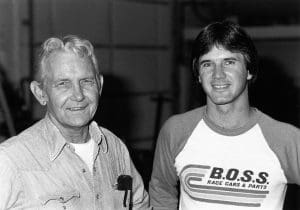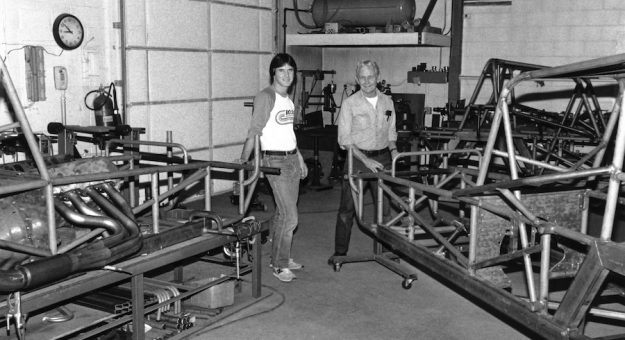Billy Pauch got a bare chassis and continued to develop it as an Olsen-Pauch hybrid from his shop in Frenchtown, N.J.
Nobody can say with certainty just how many races Olsen cars won, but during the 1980s B.O.S.S. was arguably the preeminent builder of dirt modifieds in terms of cars produced. This is where the next Olsen generation comes into the story.
Long before he stepped away from the classroom, Doug Olsen had become steeped in the nuances of building modifieds, but unlike his sometimes gruff father, he had people skills that were priceless when it came to running a business.
“When Billy (Pauch) got his first frame, he called the shop and said he was having problems,” Swanson recalled. “Budd told him, ‘You’re a smart (guy), you’ll figure it out.’ Doug was just like his father, only without any of the hard edges. He was personable and charming and hands on, and like his father, never dirty or a hair out of place, ever. He was more the people side of B.O.S.S. Like Brett Hearn used to say, when you called B.O.S.S., you hoped it was Doug that you got on the phone.”

Frank Cozze and Doug Olsen were a team, traveling the speedways while Cozze acclimated himself to the shop’s new chassis. The legacy of B.O.S.S. can be directly attributed to its documented success. The company’s trajectory rocketed upward as it began selling modifieds by the dozens.
“When most of the field is your cars, the percentages start going up, so you’re going to win,” Cozze explained. “Doug knew a lot about racing from his dad and we learned more when we were traveling together. When the cars started getting popular, Hearn got one right after I got one, and the Olsens started getting good feedback from the drivers, which is what you’ve got to have with an organization of their type. You have cars, cars, cars and the more cars you have, the more feedback you get and the more you understand. At that point, tires were starting to evolve and the shocks were getting better, so there was a lot to learn.
“Budd was successful because he was such a hands-on guy, and I don’t think there was a better fabricator,” Cozze continued. “I drove their car from 1977 to 1979. I probably drove every one (of the major factory-built modified chassis) ever made at some point. It helped Olsen that they were pretty consistent in their assembly. When you’re 22 like I was, you’re not paying too much attention to things like that. I’d go to their shop in New Jersey and everything was super clean. It looked like you were in a hospital room. For a guy 22 years old, it was something.”
Budd Olsen died in 1991 due to complications from a longstanding struggle with cancer. Doug Olsen beat cancer, but was claimed by the COVID-19 pandemic. After cranking out winning race cars for more than 25 years, B.O.S.S. was sold and ultimately shut down.
Today, the Olsen tradition is written in the memories of the men who built it from scratch. As Swanson puts it, “They were totally professional. Completely and utterly, in everything they did. Nothing was ever slipshod or done hastily in any way, shape or form.”
Cozze, too, was moved by the Olsen family’s quiet commitment to excellence.
“Budd was exactly like my father, which was probably why I understood him, because a lot of people didn’t,” Cozze said. “He was the kind of guy who’d say, ‘Don’t give me an excuse, but tell me what happened.’ If you didn’t drive your butt off, he wasn’t happy.
“If you were supposed to get to work at 6 o’clock and if you got there at 6, you were an hour late.”
This story appeared in the Nov 29, 2023 edition of the SPEED SPORT Insider.

